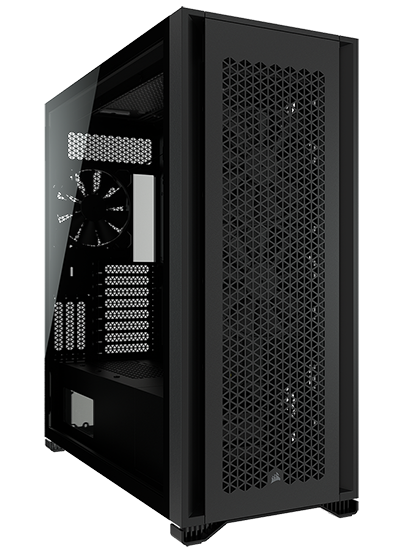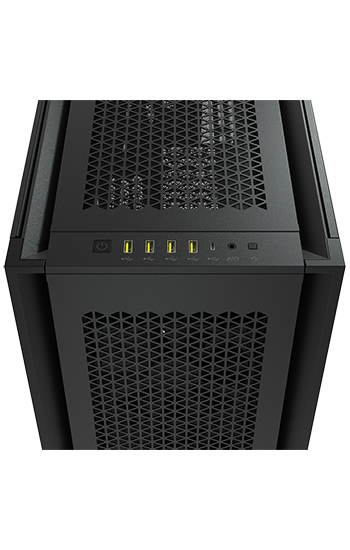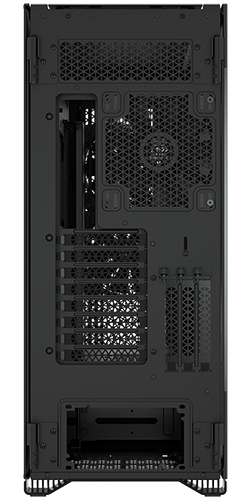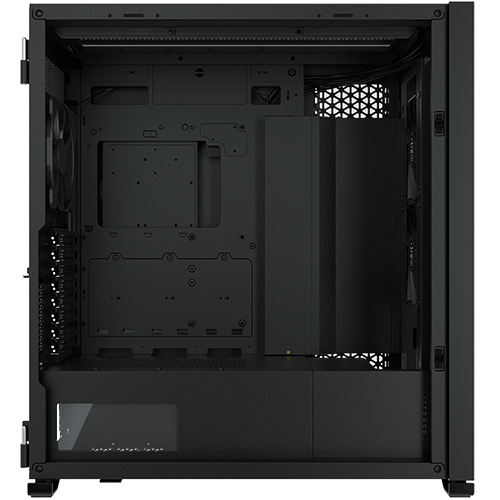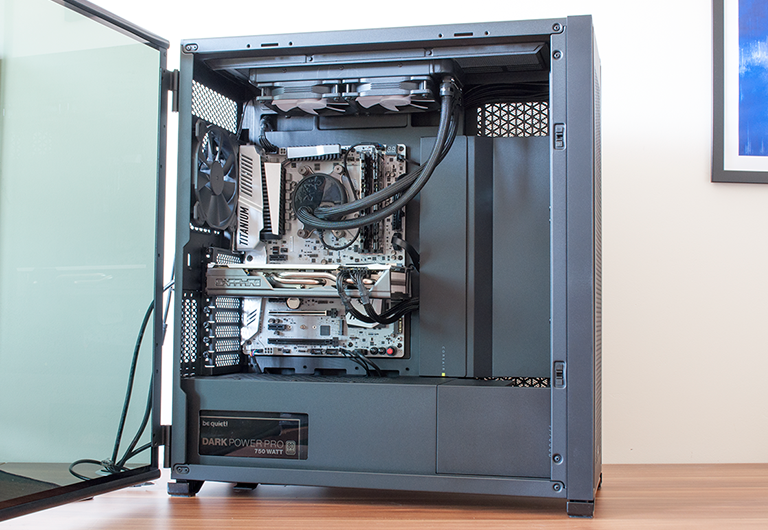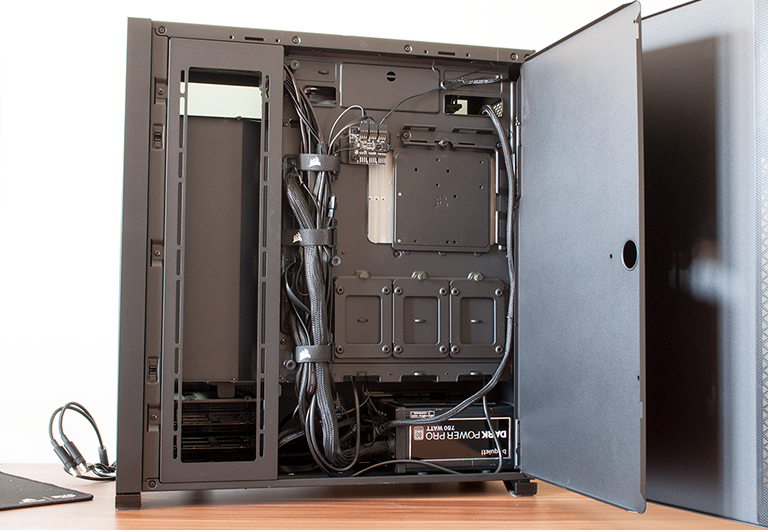Introduction
It is literally turning out to be a big week for Corsair. Having launched its largest all-in-one cooler to date, the iCue H170i Elite Capellix, the firm is also rolling out a suitable enclosure for such expansive hardware in the form of the super-sized 7000 Series.
This full-tower behemoth is being made available in glass-laden RGB and mesh-covered airflow variations, each in a choice of black or white, and is designed first and foremost to offer massive cooling potential. We're talking room for three 360mm or two 420mm radiators, or even a 480mm if you have the urge, and there's no need to be modest; we know many of you have more PC fans than you let on.
Our £240 7000D Airflow review unit is really quite striking, with a full-height glass side panel providing a monolithic look that demands attention in any room. We don't see many full-tower solutions these days, and the huge 600mm (H) x 248mm (W) x 550mm (L) form factor represents a significant step-up in size from Corsair's existing mid-tower sibling, the 5000D. If you crave extra room to build with, the 7000D touts almost a 25 per cent increase in overall volume.
It's a giant alright, yet Corsair does well to maintain a familiar design language across the range. The 4000D, 5000D and 7000D are all instantly recognisable, and each comes across as clean and modern, with sleek lines, elegant mesh panelling and good symmetry throughout. Despite being blown-up to these proportions, the 7000D remains an attractive piece of kit.
Corsair's large doors swing open to provide easy access and convey a high-quality feel, as do the metal top and front covers, however you will notice less rigidity in other areas. Plastic elements such as the front bezel have extended to such lengths that they naturally exhibit a bit of flex, and there are other elements that feel economical. The removable Perspex window on the side of the PSU shroud is lightweight and has a tendency to rattle about, and on an all-black case as bold as this, we're saddened to see the paint on our review sample beginning to flake across the top inner edge. Here's hoping that's an isolated issue.
In use, the 7000D mirrors a lot of the design and functionality of the smaller 5000D, albeit with more of just about everything. That includes the I/O panel, which has been upgraded to include a USB 3.1 Type-C, four USB 3.0 ports, and a combination audio jack between the customary power and reset buttons. A healthy selection, though do be sure your motherboard has all the required USB front panel connectors; one for the Type-C, and two for the Type-A.
On the inside, the enclosure feels nothing short of cavernous. A regular ATX board appears insignificant inside the belly of this beast, and we're of the opinion the 7000D works best when stripped-down to reveal every nook and cranny. The cable cover to the right of the motherboard tray is easily removed, as are the two three-bay drive cages at the end of the PSU shroud, and in keeping with the 5000D, Corsair includes an L-shaped accessory as part of the bundle that allows said shroud to be cut short in order to fully expose every available fan mount.
Speaking of which, you'll find room for a 120/140 at the rear (one 140mm included), three 120/140s up top, four 120s or three 140s in front (two 140mm included) and a further four 120s on a dedicated panel alongside the motherboard tray, giving users the ability to side-mount up to a 480mm radiator. The hinged rear side panel is outfitted with a patterned vent to maximise airflow, and comes pre-lined with a magnetic dust filter. If you are liquid cooling - which you really should be on a case of this ilk - there are plenty of ways to go about it. It is possible to simultaneously install a trio of 360mm radiators, or two of Corsair's biggest all-in-one, the aforementioned iCue H170i.
There's obviously plenty of room for a choice of motherboard form factors, up to and including E-ATX, and clearance for almost any component isn't in question. We say almost as our be quiet! power supply wouldn't go in without removing one of the drive cages beforehand, and it's a sign of the times that even a case as substantial as this features not a single 5.25in optical bay.
On the other hand, you do get an integrated SATA-powered fan hub that allows half-a-dozen four-pin fans to be connected to a single PWM header, and an 8+3 expansion-slot arrangement whose bundled converter can be used to rotate the bottom six horizontal slots to a further four vertical.
I can't imagine ever owning enough hardware to warrant a case of this magnitude, yet even on a modest build it's easy to appreciate the amount of extra room. Everything goes in with minimal fuss, cable-routing holes and tie-down points are plentiful, a choice of offset rails allows flexibility when mounting radiators, and there's good filtration throughout. The front, top and side fan mounts are all lined with mesh filters that are easy to remove, and the filter beneath the PSU pulls out to the side for easy access.
Nothing out of the ordinary - 7000D doesn't attempt to offer elaborate extras such as the ability to adjust motherboard height or invert the layout - but the pared-back aesthetic and huge canvas represent an attractive base for modding. The Perspex window in the PSU shroud is clearly ripe for customisation, yet despite the chassis' huge frame, builders may have to choose between maximum cooling or maximum storage. There are a total of 10 storage bays (six 2.5/3.5in spread across two cages, three 2.5in sleds and another 2.5 on the accessory tray attached to the CPU cutout), but choose to use all of the available fan mounts and those drive cages become at best awkward to access or, at worst, incompatible.
Cable management is good enough, with Corsair bundling a decent supply of Velcro ties, but as with the 5000D, the magnetic secondary rear door isn't great. In addition to serving no real purpose - you can't see the cables with the back panel closed - it is held in place with magnets that aren't quite strong enough. We wouldn't consider our cabling to be particularly messy, yet even so the secondary door springs open and refuses to stay shut. One other point worth considering is that the window on the black 7000D is heavily tinted. I quite like the stealthy look, but users wanting their components to be on full view should gravitate to the white model, which includes a clear window as standard.



